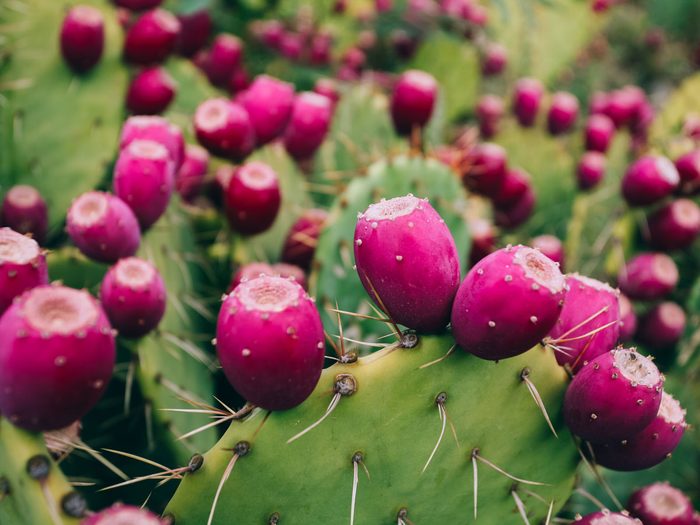
Prickly Pears
How they taste
Fluent in exotic fruits? Ever tried prickly pears (i.e., cactus pears)? These avocado-shaped fruits have a vibrant ruby-red or golden pulp that is mild and sweet (like a cross between watermelon and lemon). They often come from the Southwest U.S. or Mexico.
Why they’re good for you
Each fruit has a wealth of magnesium — more than an orange, apple and pear combined. A study published in 2009 in the American Journal of Clinical Nutrition, which involved more than 64,000 women, found that as magnesium intake went up, risk of type 2 diabetes dropped.
What to look for
Choose deep-coloured pears, and look for ones that are free of squishy, mouldy or dark spots. Store in a plastic bag in the fridge for up to a week, or at room temperature for a few days.
How to prepare them
To peel, slice off both ends and cut skin lengthwise. Slide your knife carefully under the skin and pull it off. The skin should be discarded, but the seeds are edible and pleasantly crunchy. Prickly pears are best served chilled. Add slices to fruit salads, cereal, smoothies and ice cream, or purée for use in vinaigrettes and marmalades. For an easy breakfast, try one of our healthy fruit smoothies.
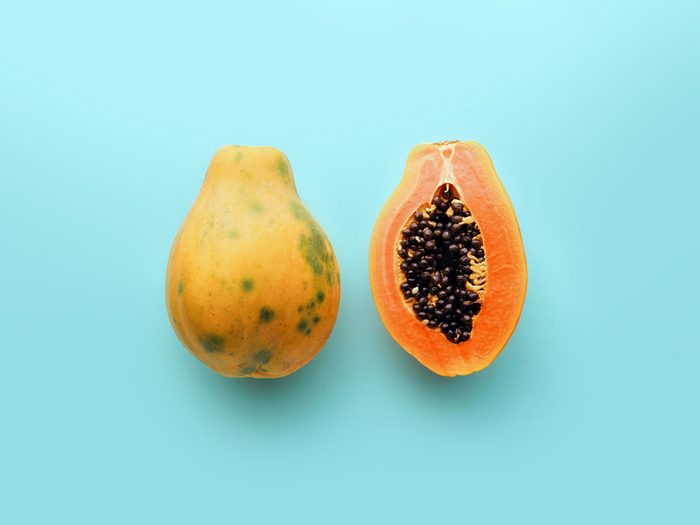
Papayas
How they taste
Dubbed “fruit of the angels” by Christopher Columbus when he first tasted them in the Caribbean Islands in the 1400s, the orange flesh of delectable papaya has a sweet-tart flavour. Most of what we find in stores today comes from Hawaii, Central America and Mexico.
Why they’re good for you
Papayas are non-acidic (so they’re good for soothing your stomach) but they are packed with vitamin C and beta-carotene (more than even orange and grapefruit), two antioxidants that may lower your risk of uterine cancer, according to a 2009 study by The Cancer Institute of New Jersey. Take this quiz to find out how much you know about antioxidants.
What to look for
Choose papayas that are blotchy yellow. When ripe, their skin should be more yellow than any other colour and should also give slightly when pressed. You can ripen a green papaya in a paper bag on your counter and then store it in the fridge in a plastic bag for up to three days.
How to prepare them
For a new twist on dessert, halve the papaya as you would a melon, remove the seeds and add one cup (250 mL) plain low-fat yogurt, one teaspoon (5 mL) honey and a squeeze of lemon or lime to the inside cavity. Or use finely diced papaya (remove the skin with a knife or vegetable peeler) in a fruit salsa. It the perfect way to work exotic fruits into an appetizer for your next dinner party!
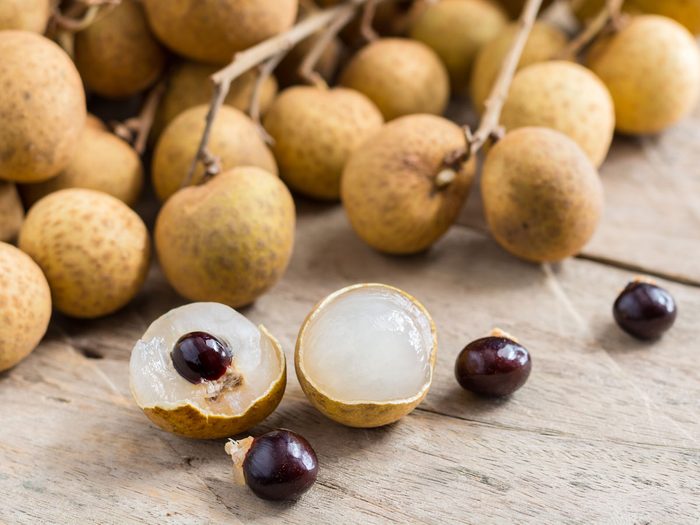
Longans
How they taste
These are often referred to as the “little brother” of the larger, red-skinned lychee. The flesh of the longan is translucent with a black seed in the centre. They taste musky but sweet with a texture like a mix of grape and pear. Longans are native to southern China.
Why they’re good for you
These bite-size gems have plenty of vitamin C, with just 100 grams of longans providing 140 percent of the daily value — and only 60 calories.
What to look for
Choose those with yellow-brown to reddish-brown, slightly flexible skin that is not too soft (an indication the fruit is too ripe), cracked or leaking. You can store longans at room temperature for several days.
How to prepare them
To eat them, crack open the inedible rind just below the stem using a knife, and pop them out, disposing of the pit inside (as you would a cherry). They are great as snacks or in a fruit salad.
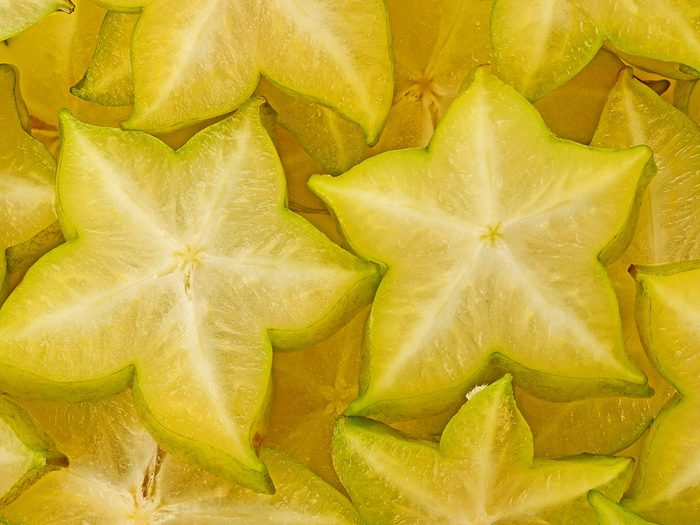
Star Fruit
How they taste
Native to Southeast Asia and India, the yellow star fruit — also known as carambola — tastes like a mixture of plum and apple, and has a sort of crunchy texture similar to cucumber. You’ll find them in Asian markets and some larger grocers.
Why they’re good for you
Each vitamin C-laden star fruit has less than 40 calories, but supplies three grams of dietary fibre — that’s two more than a plum. A 2008 Dutch study found that for every additional 10 grams of fibre consumed per day, the risk of dying from heart disease declined by 17 percent, while dying from all causes fell by nine percent. Read up on why you should increase your fibre intake STAT.
What to look for
Pick star fruit with firm, glossy skin and no signs of bruising. Browning on the tips of the ridges is a sign of ripeness, not a bad fruit. If green, store at room temperature until the fruit turns yellow and has a floral-fruity fragrance.
How to prepare them
Star fruit does not need to be skinned before slicing, unlike various other exotic fruits. Except for the seeds, you can eat the whole thing, and thanks to their pretty shape and colour they add a real wow factor to fruit platters and salads. Also, try them poached or in a exotic fruits-based chutney.
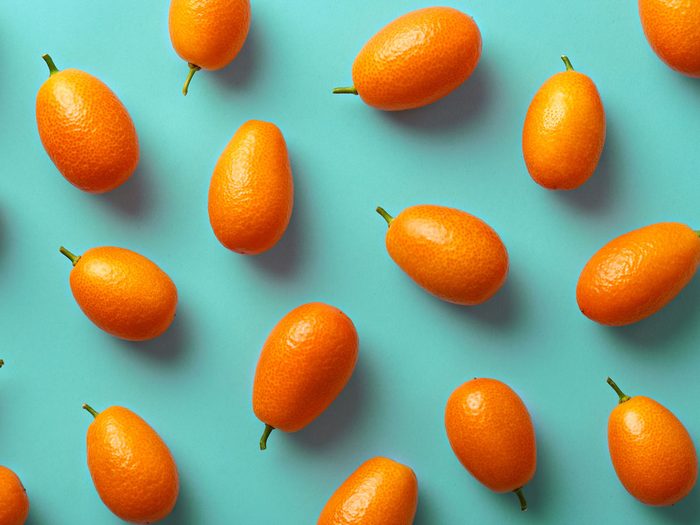
Kumquats
How they taste
Resembling a bite-size orange, a kumquat has juicy and bitter flesh, but its rind is fragrant and wonderfully sweet. These fruit are native to China but are now also being grown in the U.S.
Why they’re good for you
These tiny fruit have vitamin C levels that are almost on par with oranges and several times higher than grapes, bananas and apples. According to a 2008 University of California study, women age 18 to 21 who consume more of this antioxidant have healthier blood pressure than women who consume less. Instead of relying on exotic fruits like kumquats to help lower your blood sugar naturally, read up on these five rules.
What to look for
Choose kumquats that are firm and completely orange, with stems. Leave behind any with green skin, soft spots or blemishes. Stored in a plastic bag, they should last in the fridge for two to three weeks.
How to prepare them
Kumquats are unique among the citrus family because they can be enjoyed skin and all in a bite or two — but be sure to wash them first. Or slice them into veggie salads, cottage cheese and yogurt.
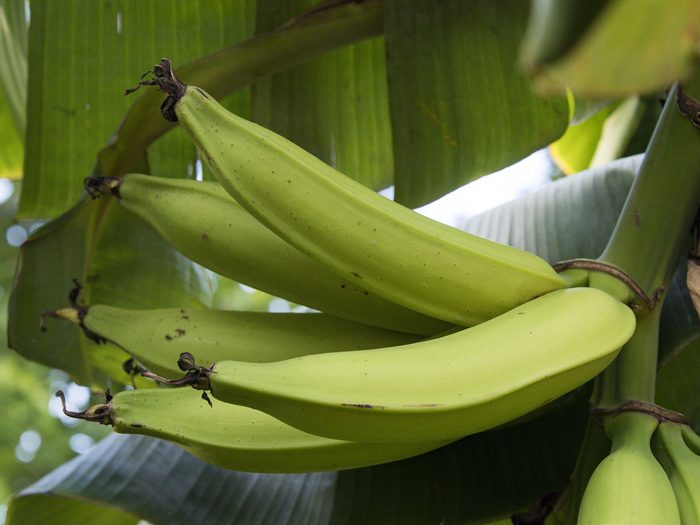
Plantains
How they taste
Plantains are native to Southeast Asia. You can also find them in Latin America, the Caribbean and parts of Africa. Green plantains, which resemble large bananas, are hard, starchy and bland, and need to be cooked before eating. As they ripen, the skin turns yellow, then black, and the flesh becomes increasingly sweet and edible; at this stage, they are okay to eat when raw.
Why they’re good for you
Plantains have more vitamins A and C, and more potassium (which lowers blood pressure), than bananas. More a fan of bananas than exotic fruits? Give this healthy banana bread recipe a try.
What to look for
Opt for plump plantains without any noticeable bruising or cracks in the skin. Similar to bananas, they are best kept at room temperature. Once they become black, you can put them in the fridge to keep for a few more days.
How to prepare them
The peel isn’t edible. To peel, cut the top and bottom off the fruit. Run the tip of a knife along the skin from top to bottom, and then peel the skin away from the pulp with your hands. Green plantains are perfect for frying — slice them and cook them in some oil in a skillet — and for thickening stews and mole sauces. As for yellow plantains that are starting to go black, they’re best prepared by gentle sautéing, grilling or roasting. They’re also good on their own or over French toast. Once completely black, they’re great for desserts such as puddings. You could also work them into winter squash soups for a nice sweetness, or blend in a blender for an exotic fruits smoothie.
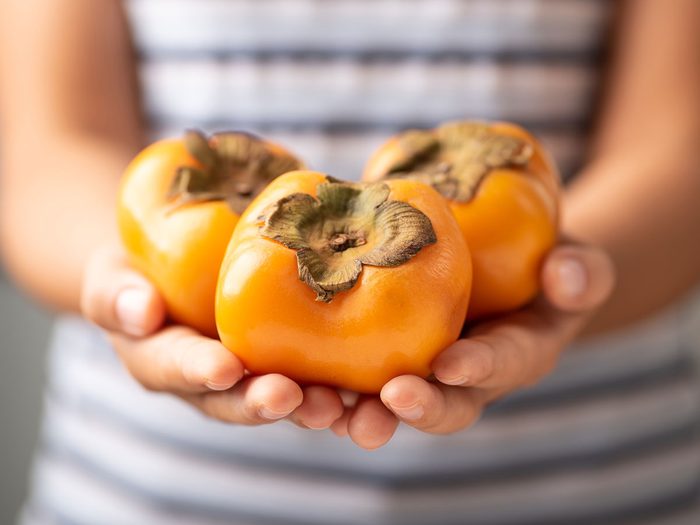
Persimmons
How they taste
There are two varieties that are commonly available in Canada. Hachiya, which is bright orange in colour and identifiable by its acorn-like shape (round with a pointy base), is soft, creamy and tangy-sweet when completely ripe. Fuyu persimmons are similar in colour but smaller and look like flattened tomatoes; they are sweeter and crisper. Both are native to China and Japan.
Why they’re good for you
As expected from the bright-orange colour, persimmons are laced with vitamin A, which helps maintain the immune system. As a perk, each also has plenty of vitamin C, and six grams of dietary fibre.
What to look for
Choose ones that have smooth, glossy skin and are plump and heavy for their size. Pass on any with blemishes, bruises or cracked skin, and those without green leaves (a sign of freshness). Keep at room temperature but, when ripe, store in a plastic bag in the fridge (they’ll keep for up to three days).
How to prepare them
Hachiya persimmons must ripen until soft, but Fuyus are sweet when firm. For both, rinse, peel with a knife and slice. Try Fuyus in fruit crisps and pies, and softer Hachiyas in vinaigrettes, custards, sorbets and sauces. Next, learn how to properly clean pesticides off your exotic fruits.
